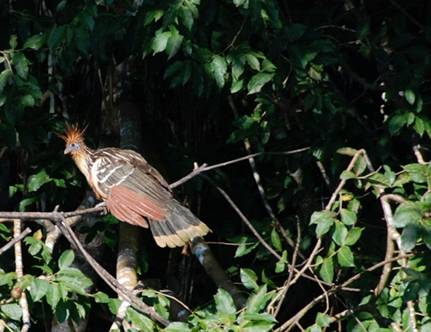Well, it’s unlikely Allisa is going to cover this one during her Seattle Audubon Master Bird Classes. This is the Hoatzin, a resident of the Amazon Basin and Orinco Delta in South America. The genus Opisthocomus comes from the Greek meaning “wearing long hair behind”. Well, ok then. This refers to the punk hairdo – or crest. This is a pheasant-sized bird – about 26 in long with a long neck, un-feathered blue face, and a maroon eye – wow! They nest in swamps or along the edges of large ponds.
The taxonomy of the species has been debated for some time and continues. The scientists just can’t seem to come to consensus on the right taxonomic category. It’s been variously classified with gamebirds, rails, bustards, sandgrouse, turacos, and mousebirds. Currently they are the only member of this Genus and of the Family Opisthocomidae. So why the problem?
This is one odd bird. First it is totally herbivorous. It has a crop and an enlarged esophagus that serve as a fermentation chamber with anaerobic bacteria that secrete enzymes allowing it to break down otherwise indigestible cellulose in plants – thus, very cow like. They “chew” leaves before swallowing and ridges in the crop help mash things up. They take a loooong time to digest – up to 45 hours for a meal to pass, so they spend about 80% of their time hanging out, chewing cud, and digesting.
Their diet has also led to their other name of “stink bird” – though I didn’t experience this. The downside to having this crop is that there is less room for a sternum and flight muscles – so in flight it is as graceful as an engorged chicken and crash lands into trees and bushes.
The other oddity is that the nestlings have two claws on their wing joint that they use for climbing. When predators threaten the nest they will bail off into water and swim under the surface. When the all clear is given by the parent they will use their claws, feet, and beak to climb back up into the nest. Early comparisons were made to reptiles and Archaeopteryx, an early bird fossil that had three claws on its wing. But the current thinking is that this is a later evolutionary adaptation. Here’s a short clip of the climbing youngsters http://www.bbc.co.uk/programmes/p00bm2c7
The birds are noisy, giving out a hoarse and creaky call – like some kind of semi-functional bike horn. This photo was taken in Madidi National Park in the Bolivian Amazon, on an ox-bow lake along the Rio Beni. These birds would become active in early morning before light, start honking and snorting, and then fly off towards the water’s edge to forage. Then at dusk the commute reverses and they start crashing into trees around the hut to roost for the evening. A very odd and entertaining bird. Just expect an early wakeup call.
